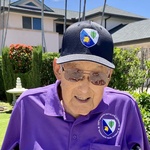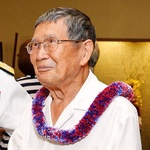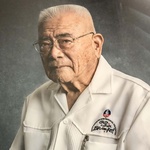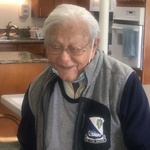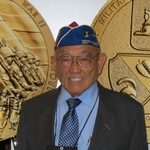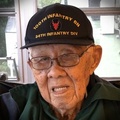
Although Albert Matsumoto, 97, never served in combat, he still maintained close ties to his fellow 100th Infantry Battalion soldiers, according to his daughter Sheila Wakai. He joined the unit in 1945 and served for two years in Italy. Because he was divorced and lived alone in a condominium a block from the Club 100 clubhouse, Matsumoto looked forward to getting together daily with fellow veterans to have breakfast and spend the day.
To show his devotion, Wakai said, her father paid for a lifetime membership for her, her sister and three grandchildren so they could help perpetuate the legacy of the 100th Infantry Battalion. “He feels it is important to continue the legacy of the 100th, and to continue utilizing the clubhouse,” Wakai said.
Takeshi Kawakami died at age 97 in Chicago on Jan. 23, 2021, just 17 days after his wife, whom he cared for as she suffered from dementia, passed away. Their daughter, Nancy van Tellingen, said her father was born in Hilo and volunteered on March 18, 1943, with his classmates and was assigned to the 100th Infantry Battalion’s Company A. She said being Japanese, volunteering after Pearl Harbor was attacked seemed obligatory to them. Van Tellingen said her father called his soldier buddies “brothers.” She added:
“During the war and after the war being Japanese was no point of pride, they suffered prejudice on the battlefield and off. My father and his fellow soldiers were all they had to rely on, and they loved each other and would die helping each other.”
When he got word that his platoon sergeant was dying, van Tellingen said, her father left his home in Chicago to sit with him and reminisce.
After the war the Nisei veterans took advantage of the GI Bill of Rights, which paid for tuition and provided a $750 a month stipend to attend the University of Hawai‘i and mainland colleges, becoming bankers, doctors, lawyers, educators and even politicians serving in Congress like 100th Infantry Battalion veteran U.S. Sen. Spark Matsunaga and 442nd Regimental Combat Team soldier U.S. Sen. Daniel Inouye. Other politicians included State Sens. Sakae Takahashi and Robert Taira, and state Rep. Howard Miyake, all of whom held elective offices as Democrats.
Mitch Maki, president and chief executive officer for the Los Angeles-based Go For Broke National Education Center, in a 2019 Hawai‘i Herald interview, said these Nisei soldiers came back to Hawai‘i “after the war, and after seeing the sacrifices of their buddies on the battlefield, they weren’t about to settle for second class status any longer.
“They took advantage of the GI Bill, and they became leaders in different domains … business, politics and education.” By helping it to become a state and then transforming it “into the state that it is today that can boast of having U.S. senators and governors and representatives, business leaders and educational leaders.”
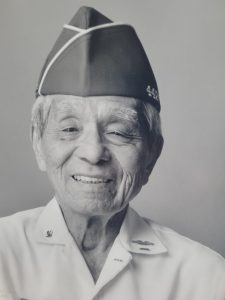
Rikio Tsuda, 98, told The Hawai‘i Herald that he “volunteered to fight for our country because of [his] loyalty even though [they] were being treated like second-class citizens.” His brother Suemasa Stanley Tsuda, was already in the 100th Infantry Battalion when Rikio Tsuda volunteered for the 442nd Regimental Combat Team on March 23, 1943.
Tsuda said he took a long time to decide his future after he was discharged in Honolulu on Jan. 4, 1946. Recalling the discrimination against Japanese Americans before the war started “and opportunities for bettering ourselves were very limited,” Tsuda used the GI bill to attend Honolulu Business College and worked at Hickam Air Force Base’s Military Airlift Command and retired after 35 years as an air traffic controller supervisor.
“I would like my family to be proud of the accomplishments of the Nisei,” said Tsuda.
A few 100th Infantry Battalion veterans like Lt. Col. Young Oak Kim and Hiroshi “Hershey” Miyamura served in combat again in the Korean War. Kim commanded the 1st Battalion and the 31st Infantry, becoming the first Asian American to command a battalion in combat. He also was awarded his second Silver Star medal. Miyamura, who arrived in Europe to join Company D as World War II ended, never saw combat. He transferred to the Army Reserve, was called to active duty during the Korean War, and received the Medal of Honor while serving with the 7th Infantry Regiment.
Two other 100th Infantry Battalion veterans—Edward M. Yoshimasu and Francis Shigeo Takemoto—joined the Hawaii Army National Guard after they were discharged in 1946 and rose to become the first Japanese Americans to wear one star as a brigadier general. Both were wounded in Italy and were awarded Purple Heart medals.
The Army legacy of the 100th Infantry Battalion continues today as the only infantry battalion in the Army Reserve and still carries the blue regimental flag as the 100th Infantry Battalion/442nd Infantry Regiment at Fort Shafter. The World War II unit was reactivated in August 1947 as an Army Reserve unit. The reserve unit was activated for 19 months during the Vietnam War, but never left Hawai‘i. The 100th Infantry Battalion was called back into active service in 2004 and sent to Iraq. In 2008, the battalion was activated for the third time to provide security for convoys driving from Kuwait to Iraq.
However, Maki points out that the legacy of the 100th Infantry Battalion is more than a story, a history lesson, even a military lesson for World War II “buffs” or those purely interested in the military aspect of the story. “We have to treat this as an American story with lessons from the past that are relevant to today.”
Mari Matsuda, said her father, “because of the combat he saw, he is a strong advocate for peace,” marching against the war in Vietnam and against the war in Iraq. “He is a member of Veterans for Peace,” she said. “He loves soldiers, but he hates war.”
* * * * *
The remaining known surviving Nisei warriors:
Dr. Takashi “Taka” Manago, 98, was born in Captain Cook on Hawai‘i island, the fifth son of Kinzo and Osame Manago, the founders of Kona’s famous Manago Hotel. He attended University of Hawai‘i before he was drafted in 1944 with his two older brothers, joining the 100th Infantry Battalion’s Company A serving as a litter bearer in Italy. After the war ended, he reenlisted to attend military school in Florence. After his discharge, Manago graduated from Creighton College and Fairleigh Dickinson Dental School and established a dental practice in Honolulu. He lives in Wai‘alae Kāhala with his family.
Korean War Medal of Honor recipient Hiroshi “Hershey” Miyamura, 96, was only 15 and living in Gallup, N.M. when Japan attacked Pearl Harbor. Miyamura was drafted on Feb. 29, 1944, and was assigned to Company D of the 100th Infantry Battalion. He arrived in Europe as the war ended and never saw combat but remained in the Army Reserve. He was called to active duty during the Korean War and served with the 7th Infantry Regiment. Miyamura was captured by the North Koreans on April 25, 1951 and was a prisoner of war for two years. Before he was captured, Miyamura fought off a night attack killing enemy soldiers with his bayonet and in hand-to-hand combat. His Medal of Honor citation said he personally killed 50 North Korean soldiers. His granddaughter, Marisa Miyamura, is an Air Force Academy graduate.
Masaharu “Bull” Saito declined to be interviewed for this story.
Joe Sugawara, 98, was born in Petaluma, Calif. and was sent to the incarceration camp at Amache in Colorado. His family was relocated to Cincinnati where he was drafted on April 26, 1944, and was a member of the 100th Infantry Battalion’s Company C. Sugawara earned his bachelor’s degree from the University of Cincinnati after the war and worked for the Internal Revenue Service for 20 years. He retired in Hilo where his wife, a registered nurse, is from, fulfilling a promise he made when they were married in 1951.
Don S. Miyada, 97, was born in Oceanside, Calif. He and his brother were released from Poston incarceration camp in Arizona in January 1944 to work in a defense plant in Detroit. Miyada was drafted three months later and was assigned to the 100th Infantry Battalion’s Company A. He participated in the campaign to breach Italy’s Gothic Line. After his discharge in 1946, Miyada earned his doctorate in chemistry from Michigan State University and was associate adjunct professor at the University of California, Irvine until his retirement in 1991. Miyada said he is “proud to be a part of a unit” that has such a distinguished record. He lives in Westminster, Calif.
Jack Seitoku Nakamura, 99, was born on Feb. 2, 1923, in Ewa Plantation and had earned the rank of Eagle Scout when the war began. He was 20-years-old when he volunteered to serve in the 442nd Regimental Combat Team over his mother’s (Kame’s) objections because his oldest brother, Sonsei, was already in uniform. He was in the the second group of replacements from the 442nd Regimental Combat Team and was reassigned to the 100th Infantry Battalion’s Company B where his older brother was already serving. Nakamura participated in four campaigns and was awarded two Purple Hearts. After Nakamura was discharged in 1945 he worked at Barbers Point Naval Air Station as an auditor. He lives in Pohai Nani’s Cottage care home in Kāne‘ohe.
Kazuto Shimizu, 97, was born in Pāhoa on Hawai‘i island and was inducted into the 442nd Regimental Combat Team on March 27, 1943, in Hilo and assigned to F Company. Shimizu was in the “first replacement” group of 200 soldiers who joined the 100th in Benevento, assigned to Company C in Italy. He was discharged on Christmas Eve in 1945. After graduating from the University of Hawai‘i with a degree in civil engineering he worked as a naval architect at the Pearl Harbor Naval Shipyard.
Tokuji “Toke” Yoshihashi, 99, was born in Pasadena, Calif. He is a graduate of Pasadena Junior College. His family was sent to an incarceration camp in Gila River in Arizona after the Dec. 7 attack. He and his brother, Ichiro, were drafted into the Army in May 1944. Yoshihashi joined the 100th Infantry Battalion’s Company A in Epinal, France. After the war he worked for the Los Angeles Department of Water and Power. He lives in San Gabriel, Calif.
*This article was originally published in The Hawai'i Herald on June 3, 2022
© 2022 Gregg K. Kakesako / The Hawai'i Herald


